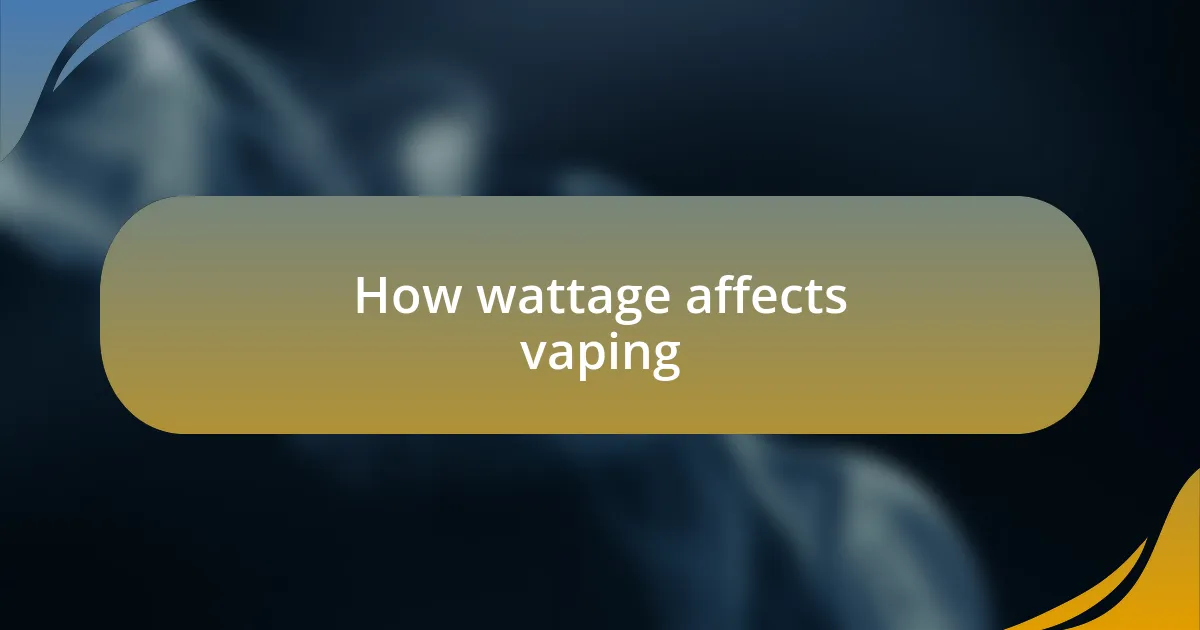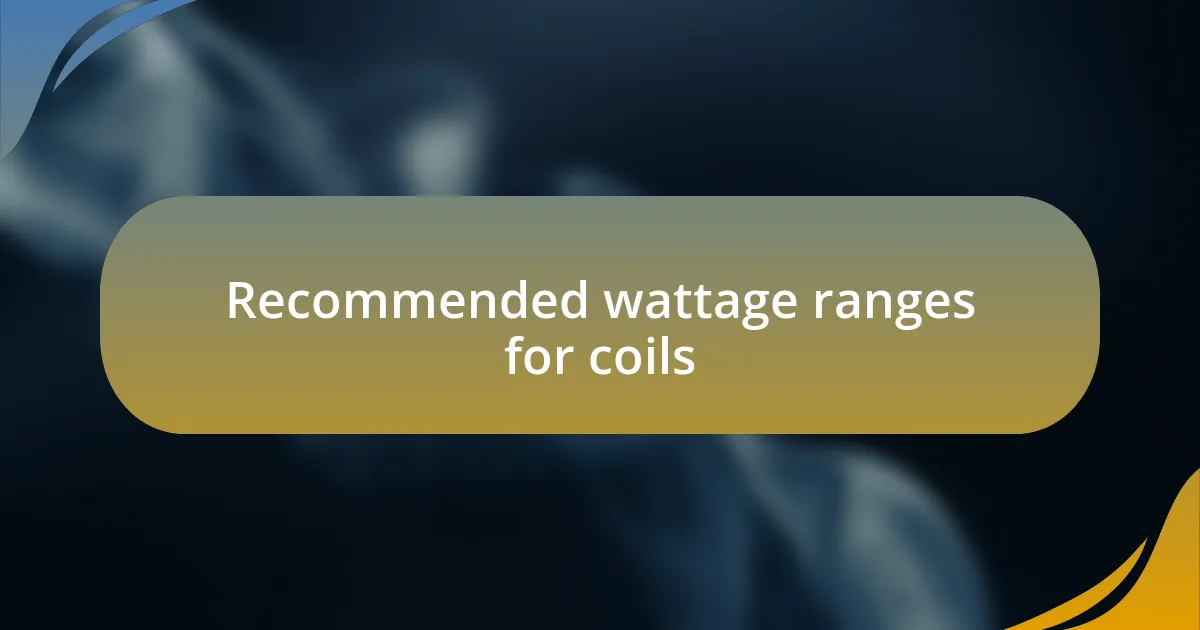Key takeaways:
- Finding the right wattage is essential for enhancing flavor, vapor production, and preventing burnt hits.
- Proper wattage settings can prolong coil life and improve overall vaping satisfaction.
- Experimenting with wattage can unveil different flavor profiles and enhance the vaping experience.
- Each type of coil has specific recommended wattage ranges for optimal performance and flavor delivery.

Understanding coil wattage settings
Coil wattage settings play a significant role in your vaping experience. For instance, I remember my first time trying different wattages. At 30 watts, I found a smooth, flavorful hit, but cranking it up to 60 watts transformed the experience into a whole new level, amplifying the vapor production.
Understanding the right wattage for your coil is crucial; it can mean the difference between a delightful experience and a burnt hit. Have you ever experienced that unpleasant taste when the wattage was too high for your coil? I certainly have, and it taught me the importance of matching the wattage to the specific coil resistance.
The sweet spot varies depending on both the coil type and the e-liquid you are using. I often explore this through trial and error, adjusting my settings based on how each combination feels. It’s like discovering a unique flavor profile with each tweak, keeping the vaping experience fresh and exciting. Where do you prefer to start when finding your ideal wattage?

Importance of proper wattage
Finding the right wattage isn’t just about maximizing vapor; it’s about crafting an enjoyable experience. I recall a time when I adjusted my wattage too quickly without respecting the coil’s limits. The result? A harsh, burnt flavor that was completely off-putting. It’s a stark reminder that treating your setup with care can make all the difference.
Proper wattage settings also enhance flavor delivery. When I discovered that lower wattages could preserve the nuanced notes of a fruity e-liquid, my perspective changed completely. Have you ever tasted a vape that just felt flat? I realized that dialing down the wattage allowed me to experience vibrant flavors I hadn’t recognized before.
Moreover, understanding wattage helps you prolong the life of your coils. I’ve learned to balance my wattage to avoid frequent replacements. Why waste money on coils that could last longer if a bit of adjustment could do the trick? Staying mindful of wattage can deepen not just your enjoyment, but also the longevity of your gear.

How wattage affects vaping
When it comes to how wattage affects vaping, I’ve noticed that higher settings can lead to a more intense throat hit. I remember trying to increase my wattage to maximize vapor production, only to find myself coughing on each inhale. Has that ever happened to you? It’s a stark reminder that more isn’t always better and that finding the sweet spot is crucial for a satisfying experience.
On the other hand, I’ve discovered that lower wattages can bring out flavors in a way that higher settings sometimes can’t. There was one evening when I switched to a lower wattage while vaping a dessert-flavored e-liquid, and the rich caramel notes really popped. It made me wonder—how often do we overlook the subtleties of our favorite flavors just because we assume more power is the way to go?
Another significant aspect of wattage is how it influences battery life. I’ve found that when I keep my settings moderate, my device lasts much longer throughout the day. Isn’t it nice to vape without worrying about recharging constantly? By experimenting with wattage, I’ve been able to enjoy vaping without that annoying interruption, which makes every session feel more enjoyable.

Recommended wattage ranges for coils
When it comes to recommended wattage ranges for coils, each type of coil has its sweet spot. For instance, I’ve found that traditional kanthal coils typically perform best between 20 to 60 watts. I once started out at 25 watts and, after a few adjustments, settled at 40 watts for the optimum balance between flavor and vapor production. Isn’t it fascinating how specific numbers can make such a difference in our experience?
For sub-ohm coils, which generally demand a bit more power, I usually aim for 50 to 100 watts. There was a time when I pushed my mesh coils up to 80 watts, and the cloud production was incredible. However, it was the flavor at the lower end of that range that left a lasting impression on me. Have you ever found that the ideal wattage felt almost like a eureka moment?
Those using higher resistance coils, like those in MTL setups, usually stick to the 10 to 30 watt range. I remember first trying a 1.0-ohm coil, and keeping the wattage below 15 felt just right for a smooth, flavorful draw. It really drove home the point that wattage isn’t just about power—it’s about crafting your unique vaping adventure.

Testing and adjusting wattage settings
Finding the perfect wattage setting often involves a bit of trial and error. I remember the first time I decided to test different levels; I started at a cautious 25 watts. Moving up gradually allowed me to pinpoint that sweet spot where the vapor was both flavorful and satisfying, and honestly, it felt like a little adventure each time I adjusted the dial.
One trick I’ve learned is to pay close attention to not just the vapor production but also the warmth of the vape. I once accidentally cranked the wattage to 70 watts on a day I was feeling bold, and the result was overwhelming. While it did produce massive clouds, the flavor suffered, reminding me that more isn’t always better. Have you ever experienced a setting that left you enjoying the vapor but wincing at the heat?
Listening to your coil is just as important as listening to your own preferences. After noticing a slight burnt taste at higher wattages during one session, I realized the need to scale back. Now, I often find myself fine-tuning between settings, and it feels rewarding to discover exactly how my personal preferences align with my gear. Isn’t it amazing how much our vaping experience can evolve just by adjusting those few extra watts?